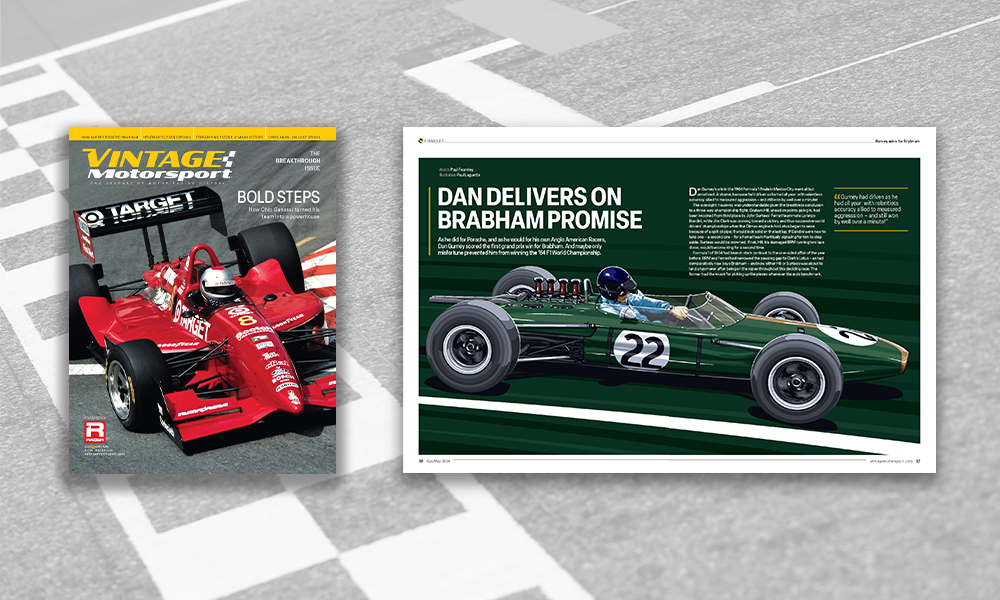Often it’s only in retrospect that we recognize a certain event as being one that ushered in a new era. The April/May issue of Vintage Motorsport takes advantage of hindsight to tell stories of prompt breakthroughs and also ones that seemingly took forever.
Fans with foresight perhaps guessed that Renault’s win at Dijon in 1979 would lead to all Formula 1 teams switching to turbocharged engines. Within two years, Renault was a title contender. And in 1982, Ferrari won the first constructors’ championship for a turbo car with its 126C2, despite a torrid season that cost Gilles Villeneuve his life and Didier Pironi his career. A year later, Brabham-BMW driver Nelson Piquet became the first turbocharged F1 World Champion.

But how many people watched Geoff Bodine capture a first NASCAR Cup win for All-Star Racing in 1984 and reckoned its owner Rick Hendrick would one day run probably the greatest team in NASCAR history? Not many. The reluctance to make such a suggestion had something to do with the gestation period: it took 11 years before Hendrick Motorsports earned its first title.

The gap between Chip Ganassi Racing’s first Indy car race win and first championship was just three seasons. But Ganassi had paid his dues, too, mixing the ingredients of his team from 1990 through ’93 until he found a winning combo. And even after the ’94 season in which Michael Andretti scored the team’s first two victories – the subject of our cover story – the team went winless in ’95; Chip needed to swap Fords for Hondas and Goodyears for Firestones before Jimmy Vasser nailed the team’s first of 15-and-counting Indy car titles.

There’s no question that Scuderia Ferrari’s first win in the 24 Hours of Le Mans, in 1954, was a breakthrough moment – far more significant than when the marque first conquered the event in ’49 thanks to a privateer entering a 166 and employing future Ferrari USA legend Luigi Chinetti as driver. The rain-soaked Le Mans triumph by José Froilán González and Maurice Trintignant five years later would eventually lead to a period where the team could hardly lose there. But could we have predicted that, especially when Jaguar D-types won Le Mans for the next three years?

The idea that Brabham would become a major force in F1 following Dan Gurney’s first victories for the team in 1964 looked much more of a sure thing. Jack Brabham and designer Ron Tauranac engineered common sense into their cars almost by default, so that they were among the strongest as well as fastest. It bugs certain fans – this writer included – that Gurney was no longer still there to take advantage of Brabham’s first period of excellence, 1966-’67, but had instead followed his friend Jack down the team owner/constructor/driver path. Yet that restless quest for new worlds to conquer was Dan. And it paid off – in F1 briefly, in Indy car racing for well over a decade, and in IMSA domination, too.

And how about the Grand Prix of Long Beach managing to thrive despite a switch from exotic F1 to domestic Indy cars in 1984? This year is the 40th anniversary of that changeover and will also be the 49th edition of an event that, in its initial iteration in September 1975, was for Formula 5000 cars.
Mario Andretti, predictably the only driver to win the GPLB as both an F1 round (1977) and an Indy car race (’84, ’85 and ’87) was certain it would work as a temporary course with a permanent place on the Indy car racing schedule. Current president and CEO of the Grand Prix Association of Long Beach, Jim Michaelian, has played a significant role in the event since its inception, and he points out that the change to Indy car racing brought a different type of breakthrough: without an eye-watering, account-draining, F1-level sanctioning fee, the event’s vital investors finally made some money.

Contrasting these tales of success, this issue of Vintage Motorsport also includes the poignant tale of Chris Amon, who never did achieve a breakthrough grand prix win, despite a talent that caused 1970 F1 World Champion Jochen Rindt to rank Amon with Jackie Stewart as his fiercest rival.

With a “My Favorite Race” from Indy car team owner Dale Coyne, a feature on Alex Job Restoration, and reports from Targa 66, The Amelia and Rallye Monte-Carlo Historique, this is the time to ensure you land a copy of the latest Vintage Motorsport.

The April/May 2024 issue of Vintage Motorsport is now mailing to subscribers and is already available to read in digital format. We hope you enjoy it. And if you’re not a subscriber, you can go to VintageMotorsport.com/Subscribe or call (877) 425-4103. Single copies can be purchased at our online store HERE. Vintage Motorsport magazine is also available at Barnes & Noble bookstores nationwide.
